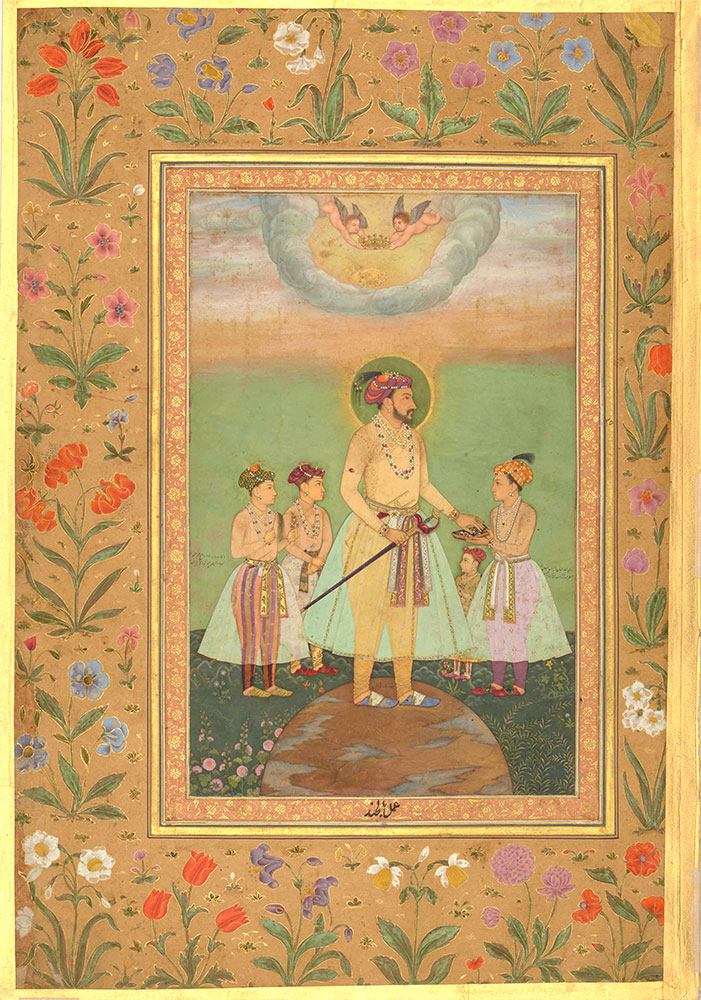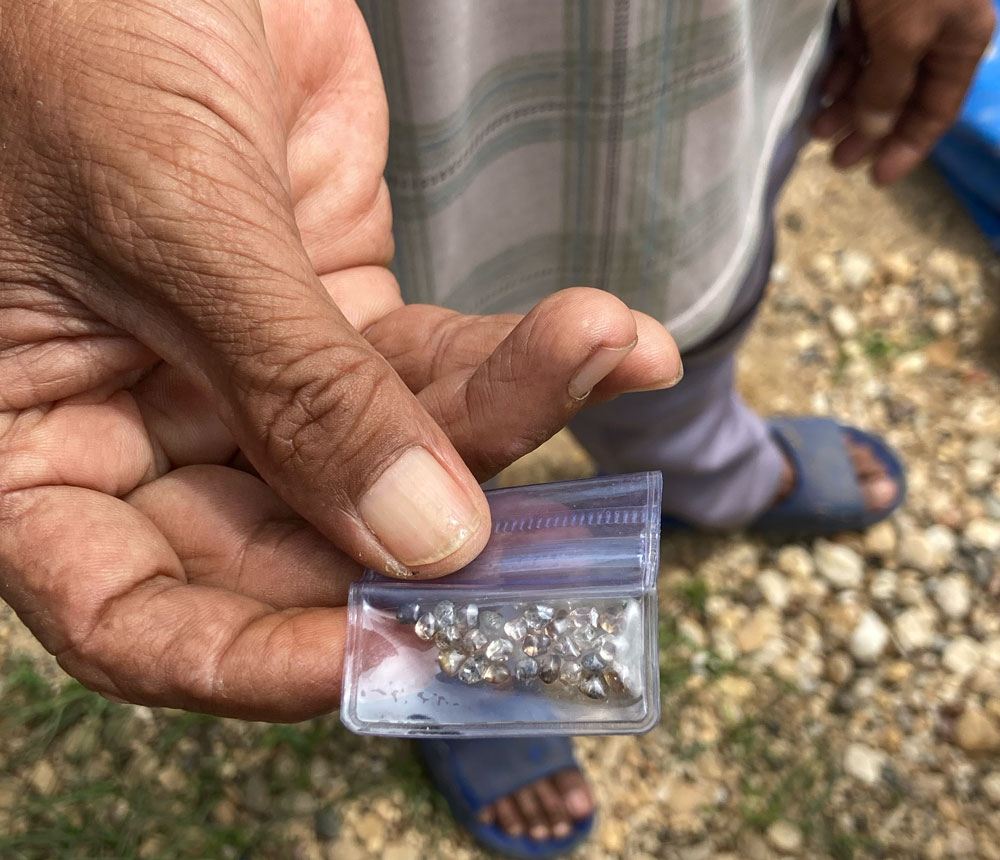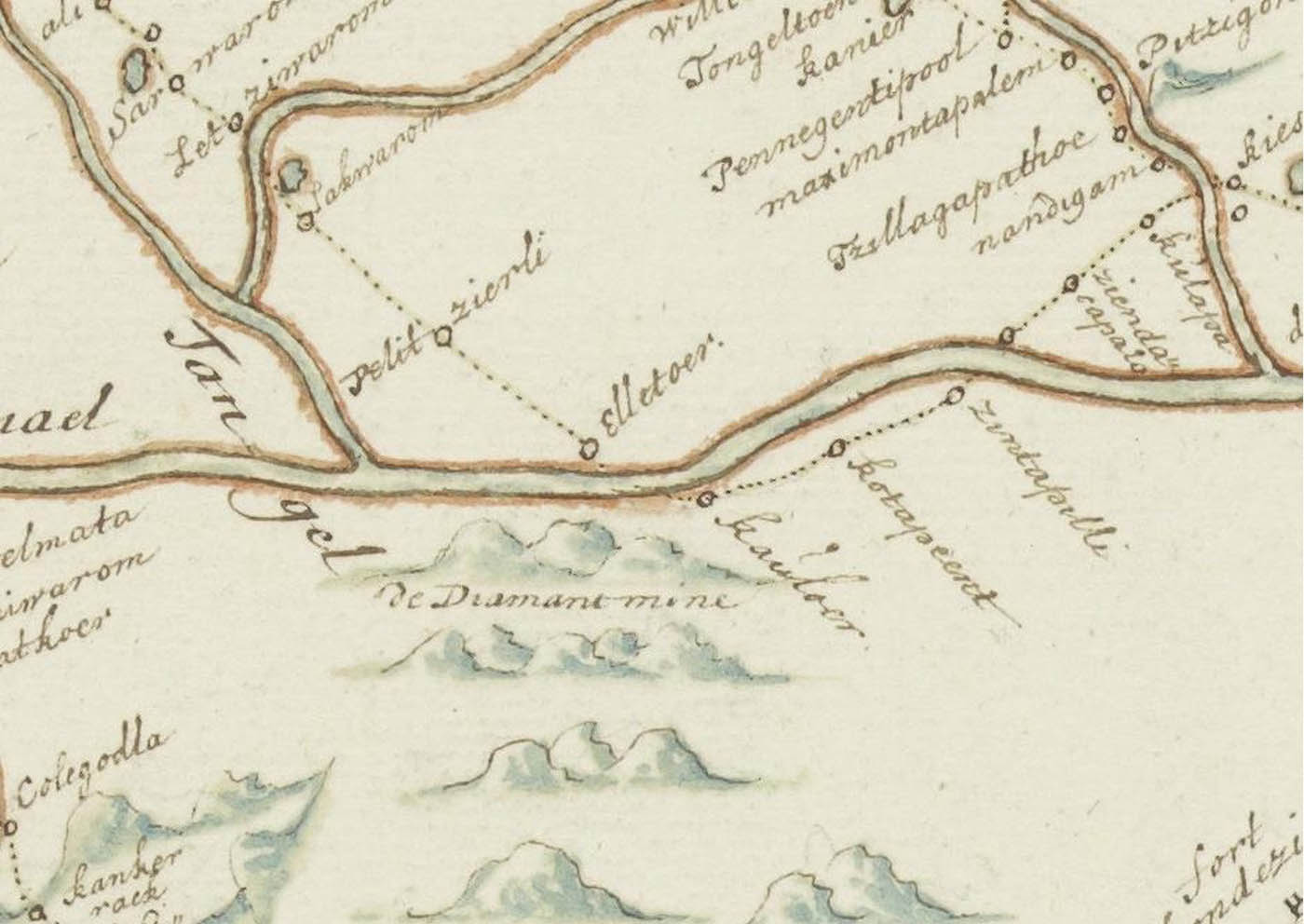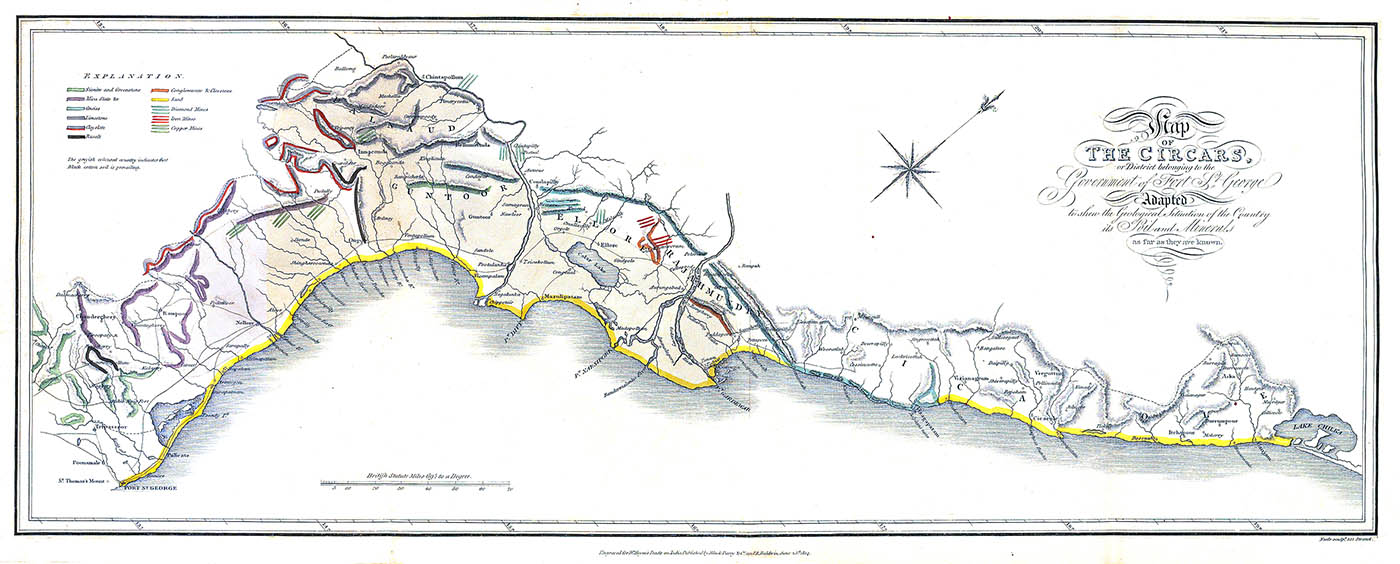Trading Gems and Knowing the Earth in Early Modern Eurasia
The “spice trade” is an essential trope of maritime Asia’s role in world history, but it is less well-known that precious stones often traveled similar routes to pepper, cloves, and nutmeg. Like spices, gems were important and expensive status symbols across the pre-modern world, as objects of spiritual and political power and as medicines that could be worn or ingested. They were also associated with distinctive geographical locations in Asia (Fig. 1). Indeed, some of the most important gem localities of the pre-modern world were found in the same regions as spices in South and Southeast Asia. The unique geography of gemstones not only attracted merchants’ attention from across the Indian Ocean – it was also of considerable interest to scholars of the early modern world concerned with the composition of the globe.

Fig. 1: Shah Jahan on a Globe with His Four Sons, Balchand, paper, pigment and gold, 392 x 284mm, c. 1628-1630, folio from the Minto Album, Chester Beatty Memorial Library, Dublin, https://viewer.cbl.ie/viewer/image/In_07A_10/2/. Image courtesy of the Chester Beatty Memorial Library.
Gems before geology
Before the discovery of diamonds in Brazil in the mid-18th century, the only known diamond deposits in the world were found in parts of what are now India and Indonesia. South Asia’s most significant diamond mines were controlled by sultanates in the Deccan, principally Golconda and Bijapur, throughout most of the 16th and 17th centuries. Islamic sultanates also controlled several smaller diamond localities in western and southern parts of Borneo, which in contrast to those of the Deccan, are still mined today. (Fig 2) Maritime traders dealing in gems traversed the Bay of Bengal to buy both diamonds and colored stones, which were mined in Sri Lanka, Thailand, and Myanmar. The latter regions were home to many of the rubies, sapphires, topaz, tourmalines, and zircons in regional circulation at the time, which also traveled overland to China. 1 Pearls, too, came from sources spanning the Indian Ocean, from the Persian Gulf, the Gulf of Mannar, and the Mergui Archipelago. The complex geography of the premodern gem trade sustained a rich gemological literature in Arabic and Persian, often commissioned by rulers whose courts purchased most of the stones. Jewelers and traders triangulated the diverse origins of gems in books recording stones’ physical qualities, where they were found, how they were mined, and how lapidaries cut, polished, enhanced, and tested them.

Fig. 2: Artisanal diamond miners in Cempaka, an historic diamond mining region in South Kalimantan, Indonesia. Photo by the author, 2023.
While the Indian Ocean gem trade had supplied Europe with gems since antiquity, European scholars and consumers had little information about the places where gems were found. Europe was comparatively poor in gem deposits, except for garnet, opal, and amethyist localities in Central Europe. And throughout the Middle Ages, most gemstones reached Europe by land routes via the Middle East, arriving overland through Turkey and the Balkans or on ships across the Mediterranean. As soon as European participants entered Indian Ocean trade around 1500 via direct maritime routes, they sought knowledge of elusive and precious stones directly from their sources. From the periphery of gemological expertise, European merchants as well as natural philosophers sought to learn more about how to buy, sell, and use these precious minerals, and to answer the question: how was it that such minerals could only be found in very specific places on the earth?
Unlike exotic plants or animals, minerals could not be transplanted to be studied or cultivated in situ. This required seeking out observations of gemstones by visiting markets and mines directly, which an increasing number of European goldsmiths, jewelers, and merchants attempted over the 16th and 17th centuries. Setting out on military, missionary, and commercial voyages, they followed existing networks of the Indian Ocean gem trade from the coastal port cities where Europeans settled, tracing stones further afield. During his residence in Melaka from 1512 to 1515, the Portuguese apothecary Tomé Pires (c. 1468–c. 1524/1540) learned of sources of precious stones around the Bay of Bengal, including Ceylon, Arakan, and Pegu (parts of modern Sri Lanka, Myanmar, and Thailand, respectively).2 His contemporary, Italian adventurer Ludovico Varthema (1470–1517), corroborated Portuguese reports on the dynamism of the region's gem trade. Varthema declared of Bengal: “here are the richest merchants I ever met with,” whose wares included abundant cotton, sugar, ginger, and silk. “There are also here very great merchants in jewels,” he noted, but their wares “come from other countries.”3
After Flemish soldier Jacques de Coutre had disembarked a Portuguese ship at Goa in 1592, he ventured onward to Melaka, seeking a fortune in Asian trade. Initially buying and selling diamonds at Pahang and Johor (which would have been imported from their client states in Borneo), he later traveled to India in 1611 to buy diamonds directly at the Deccan mines, spending several years working with Gujarati, Portuguese, and Ottoman Jewish merchants. De Coutre offered to handsomely compensate Tamil and Telugu “mine diggers to get me some stones with diamonds in them” as evidence of the kinds of rocks in which diamonds originated. Such samples would have been procured at considerable risk to the supplying miners, who were severely punished for smuggling and private dealings. De Coutre reportedly collected 160 samples of diamond-bearing rocks that he sent to his brother “to show to our friends in Europe.” 4 He described the color and texture of earth at different diamond localities, as had been pointed out to him by miners, as evidence for the geological conditions conducive to gem formation. Ultimately, the new insights relayed by people like de Coutre back to Europe – specifically, about how diamonds formed in the ground – relied on the existing expertise of the merchants he did business with and on the skilled techniques of the South Asian laborers he observed.
Gems and geopolitics on the ground
Because of its strategic location for intra-Asian shipping, the port-city of Melaka continued to be the target of European forays into Southeast Asia. When the Dutch East India Company admiral Cornelis Matelieff de Jonge (c.1569–1632) arrived in Melaka, it was with the intention to wrest the city from the control of the Portuguese, who had seized it in 1511. The Dutch set their eyes on the Malay peninsula as a base from which to wrangle a share of Indian Ocean commerce for the newly founded Dutch Republic. In the early 17th century, Melaka was a small European-controlled enclave abutting the Johor sultanate on the southern Malay peninsula. At that time Johor was ruled by Alauddin Riayat Shah III (r. 1597-1615) and his step-brother, Raja Bongsu (1571-1623).5 Amidst the growing political threat from neighboring Aceh, in north Sumatra, and the incursion of new European political elements, Bongsu negotiated a series of treaties with Matelieff and sent a diplomatic delegation to Holland.6
Raja Bongsu was also responsible for the sultanate’s negeri (client polity) of Sambas, a region in western Borneo rich in diamonds, which were sent to Johor as tribute (Fig. 3). Matelieff must have discussed the sources of these diamonds with Raja Bongsu, because he shared extensive information about them and their political sensitivity with his superiors after returning to the Netherlands. Like the earliest Portuguese voyages, the VOC’s first fleets brought several diamond experts (diamantkenners) to help navigate the region’s famed gem trade. Around 1610, two of them were dispatched to southern Borneo to aid in mineral prospecting in areas that would be less politically sensitive than Sambas.7

Fig 3.: Sambas Kris, steel (blade), suasa (gold and copper) inlaid with diamonds (hilt), 6.5 x 2.5cm, c. 18th-19th century, British Museum, London, https://www.britishmuseum.org/collection/object/A_As-Bk-88-a. Image Courtesy of The Trustees of the British Museum. Shared under a Creative Commons Attribution-NonCommercial-ShareAlike 4.0 International (CC BY-NC-SA 4.0) license
After Matelieff’s departure, Raja Bongsu commissioned a revised copy of the Sejarah Melayu, the Malay dynastic chronicles. This updated the history of the sultanate from its mid-16th-century genealogy in order to celebrate the legitimacy and longevity of Bongsu’s dynasty. The text glitters with jewels presented to these rulers and is an early source of evidence for the association of Johor with gemstones.8 While Bongsu celebrated Johor’s illustrious past, Matelieff composed a series of memoranda for the VOC focusing on the present and immediate future of the region, taking note of its role in the Southeast Asian gem trade. He advised that interfering with the Sambas diamond deposits in Borneo might yield conflict with Johor. Matelieff proposed instead to cultivate trade with Sukadana, a small polity to the south of Sambas, as the diamond trade would be a “very important business with a lot of money involved” for the Company. However, he warned, “the entire trade consists in subtlety and knowledge” which the Dutch would need in order to realize profits from precious stones. 9 How exactly to obtain and protect such knowledge was an enduring concern for European colonial commerce and science throughout the early modern period, leading to various attempts to understand the geography of gem deposits. 10 (Fig 4) Ultimately, regional conflict between many of the coastal polities of Borneo displaced Europeans from a permanent commercial presence there throughout much of the 17th century, preventing sustained engagement with the island’s diamond mines. However, when Banjar became a Dutch protectorate in 1787, diamonds were at the forefront of the agenda, both for the East India Company and the newly established Batavian Society for Arts and Sciences (Bataviaasch Genootschap voor Kunsten en Wetenschappen). The Society’s journal highlighted the island’s diamond mines in its report on Borneo in 1780, describing how local prospectors (malim) could discern the shining diamonds in the ground and advise on which places to dig. 11

Figu. 4: Detail from 1671 map showing the journey of Dutch East India Company merchant Pieter Smith from Paliacatte to Golkonda, including a stop at diamond mines on the Krishna River. Dutch National Archives, https://www.nationaalarchief.nl/onderzoeken/archief/4.VEL/invnr/1078/file/NL-HaNA_4.VEL_1078.
Meanwhile, the English East India Company’s gradual growth in Indian coastal trade over the course of the 17th century led to increasing English investment in gemstones. By the late 17th century, London superseded Amsterdam as the European center for diamond imports. Informal exchange of information among jewelers, goldsmiths, merchants, and scholars in London was aided by the establishment of The Royal Society of London for Improving Natural Knowledge in 1660, one of Europe’s most influential and long-lasting scientific associations. At the Society’s meetings, learned naturalists, nobility, traders, and artisans often discussed the nature of distant places. The very first inquiry for the East Indies published by the Royal Society’s journal, The Philosophical Transactions, asked whether diamonds replenished themselves. 12 This set of queries was intended for merchants and travelers, to help them gather intelligence for scholars in London about curious features of the globe. And indeed, the most detailed early modern European account of how diamonds were mined in India was published in the Philosophical Transactions just a few years later in 1677. It described how in the Deccan, “the expertest Labourers are employed in searching” for diamonds, requiring considerable skill since “diamonds are so scattered and dispersed in the Earth.” 13
While regional conflict in Borneo kept Europeans largely out of the island’s mines, diamonds from Borneo nevertheless reached Europe. In 1682, an embassy from the polity of Banten in Western Java arrived in England with a cargo of rough diamonds, pepper, and a bejeweled sculpture of a peacock. The diamonds would have been sourced from Banten’s tributary polity of Landak in western Borneo and perhaps supplemented by other gems from regional trade. The mission ultimately was for naught, due to an internal power struggle between Banten’s two rulers, Sultan Haji (Abdul Kahhar) and his father Sultan Ageng Tirtayasa (Abul Fath Abdul Fattah), which led the young ruler into an alliance with the Dutch. Sultan Haji granted the Dutch monopoly over trade in Banten, who rerouted his father’s returning ambassadors to Batavia, where they were detained. This new Bantenese-Dutch alliance further disrupted the archipelago’s diamond supply by bringing Dutch military backing to Landak’s frequent conflicts with its neighbor Sukadana. Eyewitness accounts to the sacking of Sukadana in the late 1690s were written by European gem traders who got caught in the crossfire. 14
Even after diamonds were discovered in Brazil in the 18th century, precious stones continued to play an important role in European imperial incursion into the Indian Ocean world. This was especially true in the renewal of the British Empire’s designs on Southeast Asia in the early 19th century. During the 1811 British invasion of Java during the Napoleonic Wars, the British East India Company placed Stamford Raffles in charge of the Netherlands East Indies. Raffles had great expectations of the archipelago. “The acquisition of a range of countries, apparently possessing the most valuable gold and diamond mines in the world,” he wrote to the Governor General of India, had the potential to restore the empire’s diminished coffers. 15 When deliberating on the return of these islands to Dutch control several years later, Raffles compared the mineral resources of Borneo to those of the Americas, claiming gold and diamonds made the island “as rich perhaps … as Mexico or Peru.” 16
Raffles dreamed that the British might replicate the extractive exploits of the early modern Iberian empires in the New World. While rivalry with the Portuguese in Asia had fueled the ambitions of the Dutch and English East India Companies at the dawn of the 17th century, it was not until the mid-18th century that their efforts finally shifted from forced entry into marketplaces to campaigns of territorial annexation. From the second half of the 18th century, Dutch and English campaigns of military conquest laid the foundations of the more comprehensive colonial struggles of the 19th century. In establishing political control over the interiors of India and Indonesia, scientific surveys were an essential tool. The dual imperatives of mapping hinterlands and prospecting for mineral resources led to the first geological surveys of the Dutch and British East Indies, produced under the auspices of colonial rule. These efforts highlighted gem deposits among the most alluring and lucrative minerals. And in planning and executing these surveys, colonial geologists operationalized insights that had been accumulated throughout the 17th and 18th centuries, when English and Dutch merchants had begun to muscle their way into the world of the Indian Ocean gem trade.
Gems and political geology

Fig. 5: Geological map of the Circars by Benjamin Heyne, 275 x 230mm. Published in Tracts, Historical and Statistical, on India. London: C. Baltwin, 1814. 4° This is the earliest known geological map of India, based on reports compiled by Heyne after surveying Indian diamond, iron, and copper mines for the East India Company in the 1790s.
When Matelieff had arrived in Southeast Asia at the start of the 17th century, the ability of both European and Asian powers to acquire mineral resources depended on the strategic insights of artisanal, commercial, and diplomatic interlocutors, as gem deposits remained under regional control for the next two centuries. And ultimately, throughout this period, prospecting for and extracting gems continued to rely on the embodied expertise of local miners. Over some two hundred years of European expansion into the Indian Ocean world, imperial powers not only appropriated vast quantities of Asian gems, but also integrated Asian geographical, geological, and practical expertise in gems into the emerging earth sciences. By the time Raffles arrived in the early 19th century, he was able to rely on new scientific disciplines, that had been built on this global gathering of data, to understand the territories around him. Raffles’ wife Sophia described his daily routine during his years in Southeast Asia, which included writing, reading, and studying “natural history, chemistry, and geology.” 17 (Sophia also took “full share in these pursuits.” 18 ) In addition to his own studies, Raffles hired professional naturalists to survey Java, Sumatra, and Borneo, and they amassed voluminous natural history collections on his behalf, including a study of the Mineralogy of Java. 19 The old allure of gems was difficult to shake. Even into the late 19th century, Hungarian geologist Theodor Posewitz wrote in the first comprehensive survey of Borneo’s geology and mineral resources that “diamonds form the chief, and most valuable product of this island.” 20 Even though by that time gold mining was a much larger enterprise, and prices for Borneo diamonds had been significantly deflated by the arrival of South African stones on the world market.
By retracing these connections between European scientific and commercial interests in Asian gems over the early modern period, we can better appreciate the deep roots and long shadow of the colonial earth sciences. 21 Just as Raffles did not “discover” Singapore, whose presence as a thriving commercial city is testified in the reports of de Coutre some two centuries earlier, his contemporaries did not “invent” geology. Colonial geologists built on older practices of knowing and understanding the earth, by modifying and adapting techniques for accessing, extracting, and ordering the diversity of the world’s mineral productions, all of which relied on the labor of those working closest to the ground. If the emergence of geology as a field was facilitated by the changing “tectonics of empire,” as one leading historian of science has argued, then the ways of knowing the earth through its precious minerals during the previous centuries were no less political. 22 In the early modern period, precious stones were at the center of imperial, economic, and intellectual ambitions to know and control the globe. Knowledge of the earth and its polities was forged in the pursuit of the mineral commodities of distant places, whether between Java and Borneo or England and London. Imperial ambitions led scientific curiosity into the very ground itself and into intimate conversation with those who worked it. In doing so, it enabled these precious pieces of earth to become instruments of trade, diplomacy, and knowledge.
Claire C. Sabel is a Postdoctoral Researcher with the ERC Project SCARCE, at the Institute for History, University of Vienna. Email: claire.sabel@univie.ac.at